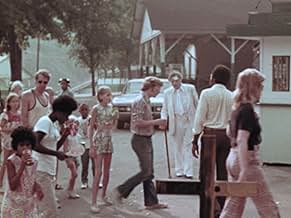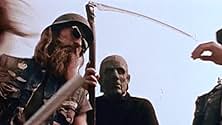The Amusement Park
- 1975
- 53m
IMDb RATING
6.3/10
3.6K
YOUR RATING
An elderly gentleman goes for what he assumes will be an ordinary day at the amusement park, only to find himself in the middle of a hellish nightmare.An elderly gentleman goes for what he assumes will be an ordinary day at the amusement park, only to find himself in the middle of a hellish nightmare.An elderly gentleman goes for what he assumes will be an ordinary day at the amusement park, only to find himself in the middle of a hellish nightmare.
- Director
- Writer
- All cast & crew
- Production, box office & more at IMDbPro
Featured reviews
This is an educational film about elder abuse shot by Romero in 1973 (early in his career) and not released until a couple of years ago. After seeing it, it's obvious why the film was shelved: it's a pure nightmarish trip, original and fresh, and very educational, but clearly not in the conventional way. Romero has in his career, until the early 80s, a maverick style of filming: very independent, rough and dirty, close to documentalists like Frederick Wiseman, and this is a great almost lost example of that period.
'The Amusement Park (1973)' is basically a PSA regarding elder abuse, bookended by extended fourth-wall breaks that outright tell you its mission statement. It's considered 'lost' because the people who commissioned it were supposedly so horrified by it that they buried it, making sure it never saw the light of day. Recently, it has been unearthed and restored in 4K, making its way over to Shudder as an exclusive piece of content. For seasoned horror fans, the flick is somewhat of an amusing oddity. It may very well be worth watching just to see what a Romero-made PSA actually looks like. However, it probably won't hit home for most audiences, despite its good intentions and general technical prowess, because it simply isn't all that engaging. Its eponymous amusement park is allegorical for life, being fun for its younger visitors but not so much fun for its older ones. Instead of height restrictions, rides are restricted by health, wage and general social status. The bumper cars require valid licences, the snack stands give out paper grocery bags, the 'freak shows' consist of only OAPs. The picture essentially puts you in the position of an innocent and eager older gentleman who gets consistently beaten down by the park's unfair systems. It's a fairly claustrophobic watch that has a relatively strong sense of escalation to it. However, even though it should work well, it ultimately falls a little flat. As I said earlier, it isn't all that engaging. In fact, it's actually quite dull. It also isn't as scary as some people are making it out to be; it's barely a horror film, if I'm honest (not that that's really an issue). I wish I liked this more than I do. 4/10.
THE AMUSEMENT PARK (1975/2019) Shot in 1973 and shelved after a couple of showings in 1975, this George Romero public service film about elder abuse has been rediscovered and remastered.
In many ways, this is a pretty remarkable document. It's a one hour semi-surrealist nightmare about an elderly man (Lincoln Manzel, who also does the introduction) who goes to an Amusement Park. There, he experiences the nightmare rides of his life: Driving, health care, indifferent and even hostile youth, poverty and just general neglect. Not having to adhere to a set 'plot', frees Romero to create some of his most striking scenarios. One bit about the man being shooed away while he's eating crackers and peanut butter and then having rats descend upon his food is as horrifying as anything in his Living Dead pictures. Romero understood that 'reality' is as frightening as anything one could conjure. It's clear why the film was just too odd, too real, for its intended purpose of being a PSA (it was financed by the Lutheran Service Society).
It's not perfect, but THE AMUSEMENT PARK is a glimpse at what Romero could have achieved if he hadn't been pigeonholed. He often played with other styles when making his commercials and industrial films (a Calgon commercial done as a parody of FANTASTIC VOYAGE etc.). This film was shot just before THE CRAZIES and one will notice several of Romero's past and future collaborators in the credits such as Richard R. Rubenstein, the Hinzmans and Michael Gornick. It's a fascinating film that is worthy of reappraisal.
Trivia: Manzel (who was also ion Romero's MARTIN) was 70 when he shot the film. He lived another 36 years! The location, West View Park in Pennsylvania, closed just four years after this movie was made.
In many ways, this is a pretty remarkable document. It's a one hour semi-surrealist nightmare about an elderly man (Lincoln Manzel, who also does the introduction) who goes to an Amusement Park. There, he experiences the nightmare rides of his life: Driving, health care, indifferent and even hostile youth, poverty and just general neglect. Not having to adhere to a set 'plot', frees Romero to create some of his most striking scenarios. One bit about the man being shooed away while he's eating crackers and peanut butter and then having rats descend upon his food is as horrifying as anything in his Living Dead pictures. Romero understood that 'reality' is as frightening as anything one could conjure. It's clear why the film was just too odd, too real, for its intended purpose of being a PSA (it was financed by the Lutheran Service Society).
It's not perfect, but THE AMUSEMENT PARK is a glimpse at what Romero could have achieved if he hadn't been pigeonholed. He often played with other styles when making his commercials and industrial films (a Calgon commercial done as a parody of FANTASTIC VOYAGE etc.). This film was shot just before THE CRAZIES and one will notice several of Romero's past and future collaborators in the credits such as Richard R. Rubenstein, the Hinzmans and Michael Gornick. It's a fascinating film that is worthy of reappraisal.
Trivia: Manzel (who was also ion Romero's MARTIN) was 70 when he shot the film. He lived another 36 years! The location, West View Park in Pennsylvania, closed just four years after this movie was made.
The topic of elderly people being mistreated in Western society is a perfectly noble one to cover in film. That doesn't exempt filmmakers from providing a story though, or character development of any kind. There's essentially zero of either in The Amusement Park, a "lost film" from the late George Romero that I'd wager is getting praised by critics because of context more than anything.
There isn't much of a film here. Our main character orates to the camera for a few minutes at the beginning, explaining just how poorly seniors are treated. Then for the next 45 odd minutes, seniors are treated poorly at an amusement park. The film plays like a not-particularly-good colourized episode of the Twilight Zone, or perhaps more accurately The Ray Bradbury Theatre.
Was excited for this based on the hype, but sadly it proved little more than a mildly curious historical novelty. Heck of a poster though.
There isn't much of a film here. Our main character orates to the camera for a few minutes at the beginning, explaining just how poorly seniors are treated. Then for the next 45 odd minutes, seniors are treated poorly at an amusement park. The film plays like a not-particularly-good colourized episode of the Twilight Zone, or perhaps more accurately The Ray Bradbury Theatre.
Was excited for this based on the hype, but sadly it proved little more than a mildly curious historical novelty. Heck of a poster though.
Answer: The Amusement Park, an hour-long film on the terrible way society treats the elder commissioned by the Lutherans and directed by the great George Romero in 1973 but not seen until now. I can only imagine that the investors, upon seeing it, said, "WTF did we pay for???"
While it is what it is--a public service film on ageism--there's no mistaking that Romero directed it. (He even shows up as a nasty patron of the park's bumper cars.) It's extremely avant garde, humorless, and depressing. But it's well done on its nothing budget and still has a lot to say on the subject today. No, it's not so terrible or unfinished that it couldn't have been released back in the day. It's was just too much. (And kudos to George's widow and the George A. Romero Foundation for doing a nice job restoring it from a couple of faded 16mm prints.) It's worth a look as a weird curio and footnote to the career of the greatest horror director who ever lived.
While it is what it is--a public service film on ageism--there's no mistaking that Romero directed it. (He even shows up as a nasty patron of the park's bumper cars.) It's extremely avant garde, humorless, and depressing. But it's well done on its nothing budget and still has a lot to say on the subject today. No, it's not so terrible or unfinished that it couldn't have been released back in the day. It's was just too much. (And kudos to George's widow and the George A. Romero Foundation for doing a nice job restoring it from a couple of faded 16mm prints.) It's worth a look as a weird curio and footnote to the career of the greatest horror director who ever lived.
Did you know
- TriviaAn organization called the Lutheran Society hired George A. Romero to create a movie about elder abuse and the importance of showing respect to older people. When Romero presented the society with his surreal and frightening take on the subject, they were so shocked and horrified by what they saw that they hid the film and never showed it to anyone. It would be 45 years before the film would be seen again.
- GoofsThe sign for requirements to go on a ride says riders can't have "hardning of arteries" instead of "hardening of arteries".
- ConnectionsFeatured in Half in the Bag: 2021 Movie Catch-Up (part 1 of 2) (2022)
Details
- Release date
- Country of origin
- Official site
- Language
- Also known as
- El parque de diversiones
- Filming locations
- West View, Pennsylvania, USA(West View Park)
- Production companies
- See more company credits at IMDbPro
Box office
- Budget
- $37,000 (estimated)
Contribute to this page
Suggest an edit or add missing content























